Finding and using public domain photographs
This page lists resources for high-quality public domain photographs. For each resource here, I tell you what you’ll find and give you tips for using the photos.
What kind of tips, you ask, if the photos are public domain? Aren’t they free of all use restrictions? Good question! And the answer is ... yeah, mostly.
Here’s the deal. Some of these resources have a mix of public domain and copyrighted photos. Also, some of the owners of the physical photos (which, yes, are in the public domain) have placed use restrictions on copies. So you need to know that. But who wants to read all those boring terms and conditions? Well ... I do! And I did, so I can tell you what they are. Often, all that’s asked of you is that you credit the photo source. So I’ve made sure to include any requested credit lines. (Crediting is the right thing to do. You’d like to be credited for your photos, wouldn’t you?)
Public domain photographs: resources
- Agricultural Research Service (ARS) Image Gallery
-

Sunflowers in Fargo, North Dakota. Photo by Bruce Fritz, Agricultural Research Service, USDA.
What’s there: High-resolution digital photos of animals, crops, insects, plants, fruits and vegetables, and illustrations from the USDA’s Agricultural Research Service staff. Duplicate transparencies and color or black-and-white prints are available by contacting the USDA Photography Center (see site for details).
Using the photos: All images are in the public domain and may be used for any purpose. However, don’t use them to infer or imply USDA/ARS endorsement of any product, service, or position. No specific credit line requested (not that I could see, anyway) ... but the photographers’ names are listed, so there’s no excuse not to give credit where it’s due.
- America From the Great Depression to World War II: FSA/OWI 1935-1945
-
What’s there: Library of Congress collection of documentary photographs created by US government photographers working for the Farm Security Administration and Office of War Information from 1935 to 1945. The collection focuses on: (i) the negative impact of the Great Depression, farm mechanization, and the Dust Bowl on rurual life, and (ii) the mobilization effort for World War II. There are some famous images by Walker Evans, Dorothea Lange, Ben Shahn (and others) here. Photographic copies may be ordered from the Library of Congress Photoduplication Service (see site for details).
Using the photos: The Library of Congress states that it is unaware of any copyright in these photos, but adds there is a slight possibility that a very small number of items may have copyrights associated with them that they couldn’t identify. The Library further notes that while they’re in the public domain in the US, the photos may be under copyright in some foreign countries and that publicity and privacy rights may apply. Suggested credit line: Library of Congress, Prints & Photographs Division, FSA-OWI Collection, [reproduction number; for example, LC-USF35-1326]
- American Memory Collection: Photos and Prints (Library of Congress)
-
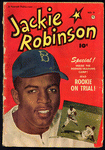
Jackie Robinson comic book. Greenwich, CT: Fawcett Publications, July 1951. Vol. 1, no. 5. Library of Congress, Serial and Government Publications Division. Reproduction number: LC-USZC4-6144 (front cover).
What’s there: The directory page for photos and prints in the digital American Memory Collection at the Library of Congress. The photos are grouped into 64 collections, with subjects ranging from Ansel Adams’ photographs of the Japanese-American internment during World War II, to early baseball photos (see "Baseball and Jackie Robinson"), to photos of quilts ... and more.
Using the photos: Much of what you’ll find in these collections is in the public domain in the US. But make sure to check the “Copyright and Other Restrictions” page of each collection you’re interested in, because not everything here is in the public domain. Items that are protected by copyright are generally marked as such, but you must check the restrictions page to find out the particulars of each collection. Plus, be aware of privacy and publicity rights if you intend to use images for trade or advertising purposes.
- Antarctic Photo Library
-
What’s there: Hundreds of photos, including wildlife (looking for penguins? you’ll find some wonderful pictures here) and stunning scenery, from the US Antarctic Program (a program of the National Science Foundation). High-res and medium-res images are available for download.
Using the photos: According to the site, all the photos are free to the public and reproduction and distribution are encouraged. But note: you must credit the photographer and the National Science Foundation. Why aren’t all of these public domain photographs? Because photographers who aren’t employees of the NSF take many of the pictures ... and they retain copyright (while granting use). So be sure to credit as requested.
- Archival Research Center, National Archives and Records Administration (NARA)
-

National Park Service (Photographer Ansel Adams); Close-up of leaves, from directly above, In Glacier National Park, Montana (1933-42).
National Archives and Records Administration (ARC Identifier: 519877).What’s there: The Archival Research Catalog (ARC), the online catalog of NARA’s nationwide holdings. Over 57,000 photos are available through ARC. This site is a real treasure trove once you grok how to use it (there’s so much information here, it’s easy to feel overwhelmed at first — but stick with it, it’s worth it).
Here’s just one quick example of what you can find. More than 200 Ansel Adams photographs of National Parks and Monuments (taken during the 1930s and 40s) have been digitized, and all are in the public domain. Quick tip: A fast way to find images is to browse the Archives’ list of online exhibits. You may order photo reproductions (see site for details).
Using the photos: The vast majority of digitized photographs in ARC are in the public domain. Restrictions, if any, will vary by collection (some materials have been donated by or obtained from individuals or organizations and may be subject to use restrictions). The record for each image will specify any use restrictions. Credit the National Archives and Records Administration as the original source of any photos you use.
- Daguerreotype Portraits and Views 1839-1864
-
What’s there: Library of Congress collection consisting of more than 725 photographs dating from 1839 (the year photography was invented) to 1864. Portrait daguerreotypes produced by the Mathew Brady studio make up the major portion of the collection. (Brady is known mainly for his Civil War photos, so this is an interesting view of his other work.) The collection also includes the earliest known portraits of President and Mrs. Abraham Lincoln.
Using the photos: All the photos are in the public domain, and the Library of Congress states that it is not aware of any restrictions on their use. Suggested credit line: Library of Congress, Prints & Photographs Division, [reproduction number; for example, LC-USZ62-110212]
- FDR Library and Museum
-
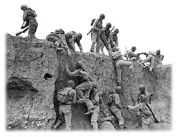
World War II Soldiers (Courtesy of the Franklin D. Roosevelt Library Digital Archives)
What’s there: Photo collection of the Franklin D. Roosevelt Presidential Library and Museum, one of ten presidential libraries administered by the National Archives and Records Administration (NARA). Includes thousands of photographs of Franklin and Eleanor Roosevelt, the Great Depression and the New Deal, and World War II. You may order prints in sizes from 4x5 to 20x24, in either matte or glossy finish (see site for details).
Using the photos: All are public domain photographs unless otherwise noted in the caption. Suggested credit line: the name(s) of the individual(s) pictured in the photograph, the place where it was taken, and the date, followed by "courtesy of the Franklin D. Roosevelt Library Digital Archives."
- Gimp-Savvy.com Copyright-Free Photo Archive
-
What’s there: Community indexed archive of more than 27,000 free photos and images (you’ll see some quirky indexing here, for sure). The images here come from three main sources: the National Aeronautics and Space Administration (NASA), the National Oceanic and Atmospheric Administration (NOAA), and the US Fish and Wildlife Service (FWS). Even though I’ve also listed those resources separately, the GIMP photo archive might be more convenient for you — a more centralized location for easier browsing. (Although I’m not sure how up-to-date the collection is.)
Using the photos: The photos are in the public domain, but you should credit any photo to the federal agency that created it. Each photo has a credit associated with it, so you’ve got no excuse. Also, be aware that some of the photos include recognizable people, so publicity and privacy rights may apply.
- Harpers Ferry Online Image Collection
-
What’s there: US National Historic Park (NHP) site offering photographs of Harpers Ferry, West Virginia. You’ll find a number of Civil War photos here, plus pictures of John Brown’s Fort, major floods, the Chesapeake & Ohio Canal, the Baltimore & Ohio Railroad. Currently there are 345 images in the online collection. You may order duplicate copies of all images in the Harpers Ferry NHP collection (see site for details).
Using the photos: Many of the photos are in the public domain, but not all. Some of the images are from private collections and copyright or other restrictions may apply. Those images are clearly identified (so you’d be able to seek permission to use from the copyright holder should you want to). Credit lines are also included in all image records, so it’s clear how you should credit any photos you use.
- NASA | Gateway to Astronaut Photography of Earth
-
What’s there: This is one of a number of National Aeronautics & Space Administration (NASA) image databases. (This one is courtesy of the Johnson Space Center.) If you’re looking for astronaut photos of Earth, start here. More than 600,000 views of Earth are accessible from this Web site. Not only that, but the site includes a tutorial on transforming images with Adobe Photoshop®.
Using the photos: The photos are in the public domain unless noted. Requested credit: “Image courtesy of the Image Science & Analysis Laboratory, NASA Johnson Space Center.” (NASA also recommends that the caption for any photograph you publish include the unique photo number and address of the Web site.) You may not use the NASA logo. Nor may you use NASA materials to state or imply NASA’s endorsement of any commercial product, service, or activity, or use them in any other misleading manner. Last, if you want to use a photo commercially and it includes a recognizable person, make sure you don’t infringe that person’s right of publicity or privacy.
- NASA | Great Images in NASA
-
What’s there: NASA collection of over 1000 images of significant historical interest scanned at high-res in three sizes. Photos are grouped by subject and by NASA center (for example, the Kennedy Space Center or the Jet Propulsion Lab). You may also search by keyword. There’s a straightforward help file, too.
Using the photos: These are public domain photographs unless noted. NASA wishes to be acknowledged as the original source of the material. Don’t use the NASA logo, though. And, as with all federal agencies, you may not use NASA materials to state or imply its endorsement of a commercial product, service or activity, or use them in a misleading way. If a recognizable person appears in a photograph, use for commercial purposes may infringe a right of publicity or privacy unless you get permission. (So get permission from Neil Armstrong before you slap his image on your book or CD-ROM cover, okay? Not that you were going to. ;)
- NASA Image Exchange (NIX)
-
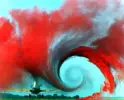
Wake vortex study at Wallops Island. Photo courtesy NASA Langley Research Center.
What’s there: Searchable online database of NASA photos (actually, not just photos but audio and video, too). You can get high-res versions of many images of the solar system (and beyond), space flights, aircraft, shock waves at Mach 1.1, and other interesting stuff.
Using the photos: The photos are in the public domain unless noted. You’re not permitted to use the NASA logo, though. And if you use any NASA material for commercial purposes, take care that your use doesn’t imply NASA’s endorsement of your goods, services, or activities. You should also be aware of right of publicity or privacy issues if an identifiable person (an astronaut, say) is in a photo you want to use for commercial purposes.
- NASA’s Visible Earth
-
What’s there: National Aeronautics & Space Administration’s online catalog of images and animations of Earth. You may browse the catalog by satellite, country, collection, US state, or GCMD (Global Change Master Directory) topic.
Using the photos: For the most part, these are public domain photographs. According to the site terms, for all non-private uses (that is, you’re distributing an image or images) there are no licensing fees but you must credit NASA as the owner of the image(s). The Terms of Use page also states that there are third-party images on the site that do require permission (contact info is provided on that page). So pay attention to that.
- National Oceanic and Atmospheric Administration (NOAA) Photo Library
-
What’s there: Collection of more than 20,000 photos, including weather and space images, images of US shores and coastal seas, and images of marine life. The collection is divided into 20 albums, and the site is easy to navigate. Also, you can find links to other NOAA photo sites here.
Using the photos: Most of the photos are in the public domain. However, you must give credit to the National Oceanic and Atmospheric Administration/Department of Commerce unless otherwise instructed to give credit to the photographer or other source. (If you go to any other NOAA sites, please do read their terms of use.)
- NYPL (New York Public Library) Digital Gallery
-
What’s there: The New York Public Library’s online gallery, which provides access to over 415,000 images in its collections. There aren’t just photographs here, but illuminated manuscripts, historical maps, vintage posters, rare prints, illustrated books, printed ephemera, and more.
Using the photos: A great many photos here are in the public domain ... but you must pay a fee if you want to do more than download a low-resolution digital image for personal, research, or study purposes only (which includes classroom use and student projects). All other uses require a usage fee. "All other uses" includes nonprofit or commercial publication, broadcast, web site, exhibition, promotional material, etc. If you want to use a public domain image owned by NYPL on your web site, for example, the current fee (for up to 5 years’ use) is $25.00 for a nonprofit site and $50.00 for a commercial site. Which is much more reasonable than the fees that well-known stock photography houses would charge you to use a public domain photo, I hasten to add.
- Open Photo
-
What’s there: Photo community site (created and run by Michael Jastremski) offering more than 3000 photographs that are free to use. (That number is an estimate; I didn’t count ’em all.) There are some nice photos here. Subjects include (among others) cats and dogs, landscapes, architecture, computers, motion, and still life.
Using the photos: This site does have some public domain photographs. Not many, though, at least when I checked. But that might change. If you click the “Read Licenses First” link in the page footer you’ll see a list of how many photos have which kind of Creative Commons license.
- PDPhoto.org
-

Strandhill Ireland. Photo courtesy PDPhoto.org.
What’s there: Jon Sullivan’s repository of photos, many of which have been dedicated to the public domain (some have not, however). This is a truly admirable site and a real gift to the public domain. Lots of photos of places (the ones of Racetrack Playa in Death Valley are among my personal faves). Some beautiful pictures of food, too. And more. Good stuff ... go take a look.
Using the photos: Many of the photos here (most, it appears) have been dedicated to the public domain. But do read the license under each of the enlarged pictures. The images that are not public domain are clearly maked as such. And if you intend to make commercial use of any of the photos, you’re warned that “you should assume no model release was obtained. And pictures featuring products or property should be used with care.” You don’t want any underlying rights problems, I’m sure. Oh, and here’s the credit line you should use (you are going to credit, aren’t you?): Photo courtesy PDPhoto.org.
- Picdrome.com
-
What’s there: Here’s another gift to the public domain. This site offers more than 800 photos in 8 categories (the largest one being travel, currently). The site is growing, too, so by the time yo visit there will be even more. Aside from the travel category there are nature, sports and recreation, food and drink, technology, textures, urban bits, and a miscellaneous category. Well worth checking out!
Using the photos: All the photos here belong to the site’s owner/administrator, who has dedicated them to the public domain using the Creative Commons public domain dedication. You can use them as you like, even for commercial purposes. To that I’d add, however, that if you intend to make commercial use of any photos having people in them (not many do, that I could see) you should assume that no model release was obtained. If you have any questions about using such photos you should contact the site owner.
- Prints and Photographs Online Catalog | Library of Congress
-

Historic American Buildings Survey, Edgar J. Kaufman house (Fallingwater).
Library of Congress, Prints & Photographs Division, HABS PA,26-OHPY.V,1-What’s there: Library of Congress online catalog through which you can access about 65% of Prints & Photographs Division holdings. There’s a ton here. Subjects range from pictures of old baseball cards to Civil War photos and Edward Curtis photos of Native Americans, to Japanese prints, to historic American buildings (such as those by McKim, Meade, & White, Frank Lloyd Wright, and Henry Hobson Richardson) ... and more. You may order high-quality prints (see site for details).
Using the photos: Many of the photos you’ll find here are in the public domain, but please note that not all images in the catalog are in the public domain. The record for each photo will clue you in to any restrictions. And here’s a handy page — the kind people at the Prints & Photographs Division have selected sets of images on frequently requested topics, focusing on images for which there are no known restrictions.
There is also a helpful list of rights and restrictions for some of the materials held by the Prints & Photographs Division. (The list can give you insight into the holdings, too. For example, I wouldn’t have known that the Library holds photos by F. Holland Day if I hadn’t browsed that list.)
- Public Domain Photos
-
What’s there: A selection of personal photos, including images of nature as well as a few urban scenes and some shots of people.
Using the photos: The photographer, Marius Iordache, has generously released these photos to the public domain. You are free to use them as you wish.
- Selected Civil War Photographs
-
What’s there: Library of Congress collection of 1,118 American Civil War photographs (part of the larger American Memory collection, which is listed above). Most of the images were made under the supervision of Mathew Brady and include scenes of military personnel, preparations for battle, and the effects of battle. The collection also includes portraits of both Confederate and Union officers, and some enlisted men. There’s also a timeline of the Civil War with links to appropriate photos, which is helpful. You may order photographic reproductions (see site for details).
Using the photos: There are no known restrictions; these are public domain photographs. Suggested credit line: Library of Congress, Prints & Photographs Division, [reproduction number, e.g., LC-B8184-3287].
- US Air Force | Air Force Link
-
What’s there: US Air Force photos grouped into the following categories: aircraft, history, memorials, natural disasters, operations, people, and remembering 9/11.
Using the photos: The photos are in the public domain. You’re asked to give appropriate credit to the Air Force and/or the photographer, however. And the photos may not be used to imply Air Force endorsement of any commercial product, service or company.
Also, many of the photos on this site include recognizable people (heck, they’re identified in the captions).The Department of Defense states here that its “imagery is provided without talent releases on any individual portrayed.” Remember .... there may be an issue of privacy or publicity rights if you intend to use images of recognizable people for commercial purposes. Last, the Air Force symbol is trademarked and is the exclusive property of the Air Force ... and the Air Force seal is protected by law from use by any party for purposes not specifically authorized by the Air Force. So don’t use them (unless you’re licensed or authorized).
- US Fish and Wildlife Service Digital Media Library
-

Credit: US Fish and Wildlife Service.
What’s there: Hundreds of images related to fish and wildlife. In addition to photos there are also sketches (black-and-white line art). You may browse the entire image library, or search all images by keyword, through the National Image Library link, or search by keyword in individual (regional) collections. I searched the National Image Library for “polar bear” and came up with these wonderful cubs. The photo is from the Alaska Image Library (duh).
Using the photos: Most of the images are in the public domain. (Note the most there.) If an image on the web site is not restricted (the USFWS logo, for example) and doesn’t say it is copyrighted, then you can assume it is in the public domain. (The records of most of the photos I checked clearly stated they were in the public domain.) If you publish any of the images the USFWS requests that you include a credit citation such as "Credit: US Fish and Wildlife Service" ... and include the artist’s name if it’s known.
- US Geological Survey (USGS) Digital Data Series DDS-21
-
What’s there: Alan Storm’s reproduction of the US Geological Survey’s Digital Data Series 21, a four CD-ROM set released in the early 1990s. It includes 1,563 images dating from 1872 to 1991. There are some great pictures here. You may browse the images by year taken, image location, or category, or you may perform a full text search of the archive.
Many of these images are already online at the USGS Earth Science Photographic Archive. The listings on this site include, where possible, a link to the USGS Archive’s version of the photograph.
Using the photos: All the photos are in the public domain. Some of the photos may include identifiable people, though, so beware of publicity and privacy rights.
- US Geological Survey (USGS) Earth Science Photographic Archive
-
What’s there: Photographic archive collection from the USGS Photo Library. There are more than 27,000 photos dating from 1868 through the present, with more photos being added on a regular basis. The collection’s emphasis is on geology, earthquake damage, national parks and monuments, pioneer photographers such as W.H. Jackson and T.H. O’Sullivan, the Mount St. Helens volcanic eruption of 1980, and mines, mills, and quarries. All photos are available in 100, 700, and 1400 dpi resolution.
Using the photos: All photographs are in the public domain. However, the site cautions that the photographs may not be used to show, by implication or otherwise, that the US Department of the Interior or the US Geological Survey endorses any product or service. Proper credit is also requested for photos that you use (credit the individual photographer and the US Geological Survey).
- US Government Graphics and Photos
-
What’s there: Directory of US government agency sites that offer photos. The directory includes some of the sites I’ve listed here and has links to even more. There are useful subject categories, too, for example “Grand Canyon National Park” and “Civil War photographs.”
Using the photos: The site states that "most of these images and graphics are available for use in the public domain; they may be used and reproduced without permission or fee. However, some images may be protected by license." So be sure to read the rights information on each site. But don’t assume everything you access through this portal is in the public domain. For example, the list includes the Smithsonian Institution. The Smithsonian’s photos are not in the public domain.
- US Navy Selected Images
-
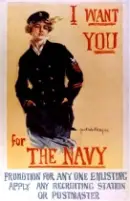
World War I Navy Recruiting Poster by artist Howard Chandler Christy, 1917. (U.S. Naval Historical Center Photograph NH 81543-KN)
What’s there: Online collection of some of the photographs and other images held by the Naval Historical Center’s Photographic Section. There are more than 19,000 individual images, according to the site, with about 200 new pictures added monthly. You won’t just find photos of ships and planes, but also photos of paintings and other works of art (for example, old Navy recruiting posters). Image resolution is slightly better than computer screen quality (96 dpi). Higher resolution images are available for all items in the collection (see details on site).
Using the photos: All photos are believed to be in the public domain, according to the web site. Since credit lines are included with each image, please do consider using them. It’s good karma.
- Wikimedia Commons
-
What’s there: The Wikimedia Foundation’s repository of free images, music, sound, video, and other multimedia works to be used in the pages of any Wikimedia project. Content is categorized by topic, medium, author, and copyright status (including public domain), and source.
Using the photos: The stuff here is free, and some of it is in the public domain ... but you must do your due diligence. Anyone with an Internet connection and a browser can contribute to the site. And that’s a good thing, but be aware that there might be some mistakes regarding copyright status. Also, and this is important, you must read the license accompanying any image you want to use, so you know what you may and may not do with your copy.
And last ... some public domain photos could bring up concerns about the rights of publicity and privacy if there are recognizable people in them. It is worth checking out the site ... you just need to use your common sense.
- Wikipedia: Public domain image resources
-
What’s there: A collection of public doman image resources, grouped by subject. Categories include objects, animals and plants, nature/science, history, locations, art, logos and flags, sports, and more.
Using the photos: According to the site, "the presence of a resource on this list does not guarantee that all or any of the images in it are in the public domain." So ... while you’ll definitely find public domain resources here, you’ll need to check the copyright status of any photograph you find through this resource. As with the other Wikipedia resources, some of the photos may actually be protected by copyright ... so do your due diligence, okay?
- World War II Photos | US National Archives and Records Administration (NARA)
-
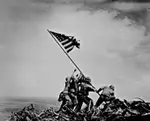
"Flag raising on Iwo Jima." Joe Rosenthal, Associated Press, February 23, 1945.
National Archives and Records Administration (ARC Identifier: 520748).What’s there: A representative sampling of World War II photographs held by the National Archives and Records Administration. The sample is a good starting point if you want an idea of the type of photos you can find in the larger collection. It’s a small sample, though. (But at least it’s not overwhelming, yes?) A larger selection is here.
Using the photos: There are no restrictions on the photos in this group. Do credit the National Archives and Records Administration as the original source, though.
